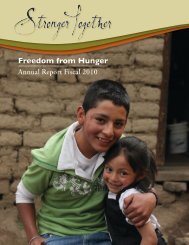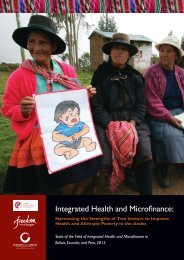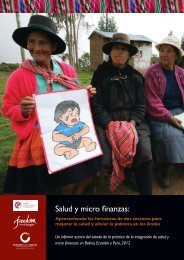history of meals for millions, soy, and freedom from ... - SoyInfo Center
history of meals for millions, soy, and freedom from ... - SoyInfo Center
history of meals for millions, soy, and freedom from ... - SoyInfo Center
You also want an ePaper? Increase the reach of your titles
YUMPU automatically turns print PDFs into web optimized ePapers that Google loves.
wiki/Clifton’s_Cafeteria. 5 p. Printed Dec. 9. [25 ref]<br />
• Summary: “Clifton’s Cafeteria, once part <strong>of</strong> a chain <strong>of</strong><br />
Clifton’s restaurants, is the oldest surviving cafeteria style<br />
eatery in Los Angeles, Cali<strong>for</strong>nia, <strong>and</strong> the largest public<br />
cafeteria in the world. Founded in 1931 by Clif<strong>for</strong>d Clinton,<br />
the name was created by combining the first half <strong>of</strong><br />
‘Clif<strong>for</strong>d’ <strong>and</strong> the last half <strong>of</strong> ‘Clinton’ to produce the name<br />
‘Clifton’s.’ The design <strong>of</strong> the restaurants included exotic<br />
decor <strong>and</strong> facades that were ‘kitschy <strong>and</strong> theatrical.’”<br />
“History: The Clinton family’s five generations as<br />
Cali<strong>for</strong>nia restaurateurs began when David Harrison Clinton<br />
came to Los Angeles <strong>from</strong> Missouri in 1888 <strong>and</strong> purchased<br />
the Southern Hotel <strong>and</strong> its dining room in downtown Los<br />
Angeles. David’s son Edmond settled in San Francisco,<br />
where he <strong>and</strong> his wife Gertrude became co-owners <strong>of</strong> a<br />
group <strong>of</strong> cafeteria-style restaurants named Dennets.<br />
“Clif<strong>for</strong>d, one <strong>of</strong> Edmond’s five children, learned the<br />
restaurant trade while working in his father’s restaurants.<br />
Along with 2 partners, he bought his father’s interest in<br />
Dennets. [Note: This investment was pr<strong>of</strong>itable enough <strong>for</strong><br />
them to leave the operation to managers while they<br />
answered “the call” to be Christian missionaries in China,<br />
self-supported by their restaurants]. Due to differences in<br />
opinion over business practices, Clif<strong>for</strong>d relinquished<br />
ownership to his partners <strong>and</strong> moved to Los Angeles in<br />
1931.<br />
“Establishing his restaurants during the height <strong>of</strong> the<br />
Great Depression, <strong>and</strong> using knowledge gained <strong>from</strong><br />
working in his family’s cafeteria chain in San Francisco,<br />
Clinton made a point to never turn anyone away, even if<br />
they had no money, seeking to average only a half-cent<br />
pr<strong>of</strong>it per customer. During one 90-day period, 10,000<br />
people ate free be<strong>for</strong>e he was able to open an emergency<br />
“Penny Caveteria” in a basement (hence the modified name)<br />
a few blocks away to feed two million patrons during the<br />
next two years.<br />
Contents: 1 History. 2 Fare. 3 Branches. 3.1 Founding<br />
branch: Clifton’s Pacific Seas (1931-1960). 3.2 Surviving<br />
branch: Clifton’s Brookdale (1935). 3.3 Lakewood (1956-<br />
2001). 3.4 West Covina (1958-1978). 3.4.1 The Greenery<br />
(1978-2003). 3.5 Century City (1966-1986). 3.6 Silver<br />
Spoon (1975-1997). 3.7 Woodl<strong>and</strong> Hills. 3.8 Laguna Hills<br />
(1987-1999). 3.9 San Bernardino (1974-1984). 4 Reception.<br />
5 In popular culture. 6 References. 7 External links.<br />
Note: As <strong>of</strong> Jan. 2011 Clifton’s Cafeteria now has one<br />
location at 648 South Broadway, Los Angeles, Cali<strong>for</strong>nia<br />
90014–near W. 7th St. Subway: Pershing Square.<br />
The Introduction states: Clifton’s Brookdale was sold to<br />
nightclub operator Andrew Meieran on September 21, 2010.<br />
Meieran intends to preserve the food <strong>and</strong> unique atmosphere<br />
<strong>of</strong> the establishment. Note: This means Brookdale is the last<br />
surviving cafeteria <strong>of</strong> what once was an 8-store chain.<br />
MEALS FOR MILLIONS, SOY, AND FREEDOM FROM HUNGER 166<br />
© Copyright Soyinfo <strong>Center</strong> 2011<br />
366. Clinton, Donald. 2010. From the life <strong>of</strong> Clif<strong>for</strong>d E.<br />
Clinton (Interview). SoyaScan Notes. Dec. 19. Compiled by<br />
William Shurtleff <strong>of</strong> Soyfoods <strong>Center</strong>.<br />
• Summary: Donald is the youngest son <strong>of</strong> Clif<strong>for</strong>d <strong>and</strong><br />
Nelda Clinton. Clif<strong>for</strong>d’s father, Edmond Jackson (“E.J.”)<br />
Clinton was born on 15 June 1872 <strong>and</strong> died on 19 Nov.<br />
1944. E.J. Clinton came to Cali<strong>for</strong>nia in 1888 at age 16. He<br />
met Gertrude Hall as a fellow student at Los Angeles High<br />
School, which was located at the time on Bunker Hill,<br />
downtown. E.J. <strong>and</strong> Gertrude were both Salvation Army<br />
<strong>of</strong>ficers; Gertrude was active in the Salvation Army Church<br />
Corps (they call their membership or congregation a<br />
“corps”). They are a Christian denomination <strong>and</strong> people go<br />
to public worship at Salvation Army churches.<br />
They were married in 1895 at a Salvation Army Revival<br />
Meeting in Los Angeles, by the Maude Ballington Booth,<br />
daughter-in-law <strong>of</strong> Salvation Army founder William Booth<br />
(1829-1912). For the next 5-6 years E.J. <strong>and</strong> Gertrude were<br />
leaders in Salvation Army work in San Bernardino, San<br />
Louis Obispo, etc. They left the Salvation Army in about<br />
1900-01 as their family was growing <strong>and</strong> moved to<br />
Berkeley. E.J. took the ferry boat across San Francisco Bay<br />
<strong>and</strong> back each day as he worked <strong>for</strong> Dennets–a small chain<br />
(several locations) <strong>of</strong> restaurants <strong>and</strong> c<strong>of</strong>fee shops that<br />
existed in San Francisco since about 1900. Not long after<br />
E.J. went to work <strong>for</strong> Dennets, then took some ownership in<br />
them, <strong>and</strong> eventually was able to acquire the name.<br />
In 1905, when Dennets was pr<strong>of</strong>itable, the family left<br />
on its first trip to China as self-supporting missionaries;<br />
Clif<strong>for</strong>d (age 5) <strong>and</strong> two or three <strong>of</strong> his sisters went too.<br />
Clif<strong>for</strong>d was the third child born; he eventually had two<br />
brothers <strong>and</strong> six sisters. They went to Taimingfu (Chihli<br />
Prov.) in northern China, to work with the Houlding Group,<br />
a missionary group organized by Rev. Horace W. Houlding–<br />
which was not related to the Salvation Army. They stayed in<br />
China <strong>for</strong> only about one year, until E.J., Clif<strong>for</strong>d’s father,<br />
received a brief notice in April 1906 that his business had<br />
been destroyed; the father quickly returned to San Francisco<br />
alone, only to find that much <strong>of</strong> San Francisco, as well as<br />
his business, had been destroyed by the earthquake <strong>and</strong> fire.<br />
E.J. contacted his wife <strong>and</strong> family in China, <strong>and</strong> asked them<br />
to return to Cali<strong>for</strong>nia because it would take him a few years<br />
to rebuild the family business.<br />
Clif<strong>for</strong>d, only 5-6 years old, returned to the Bay Area<br />
with his mother <strong>and</strong> sisters. Clif<strong>for</strong>d returned to grammar<br />
school (probably at Washington Elementary School) in<br />
Berkeley where his family lived; where he continued at this<br />
school <strong>for</strong> the next two years, until about 3rd or 4th grade.<br />
In 1910, with the business again pr<strong>of</strong>itable, the entire<br />
family returned to China, but this time to south China <strong>and</strong><br />
the area around Canton (Guangzhou), to a city named<br />
Shiuhing (shown on a map in the Dec. 1937 issue <strong>of</strong><br />
National Geographic Magazine). Today this city is named<br />
Zhaoqing (pronounced jou-ching; Variant name: Shiuhing;















